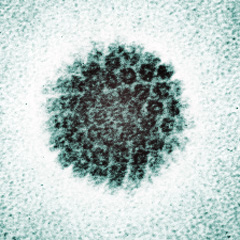Human Papillomavirus (HPV) is a sexually transmitted virus that can cause a variety of unpleasant symptoms, including genital warts and cervical cancer. While the Center for Disease Control (CDC) estimates that around 79 million Americans are infected, most people with HPV do not develop any symptoms. Despite its prevalence, the intricacies of HPV are not fully understood, particularly how HPV infects and takes control of host cells.
HPV is a small, non-enveloped DNA virus. Enveloped viruses can usually infect a cell by fusing to its outer membrane like two bubbles combining to form one, but non-enveloped viruses are unable to use this mechanism. Instead, HPV utilizes a cellular process called endocytosis to enter the cell. In endocytosis, the cell membrane wraps around an object and pinches off, creating a small bubble called an endosome containing the object. Scientists have known about this mechanism for some time, but to actually infect a cell, HPV must find a way to the nucleus. In past studies, scientists have found that HPV uses the retrograde transport pathway—which goes from the Golgi body to the endoplasmic reticulum. This pathway is the reverse of how materials are usually transported in the cell. However, scientists were still unsure how HPV escaped the endosome to first enter the retrograde pathway.
Daniel DiMaio, Yale Waldemar Von Zedtwitz Professor of Molecular Biophysics and Biochemistry; Genetics; and Therapeutic Radiology has been working with papillomaviruses since the 1980s and decided to investigate the mechanism HPV uses to get out of the endosome and into the cytoplasm inside the cell to enter the retrograde transport pathway. DiMaio and his team hypothesized that the virus might utilize cell-penetrating peptides (CPPs) to poke through the membrane of the endosome and expose a binding site, signaling the cell to induct the virus into the retrograde transport pathway, giving it a path towards the nucleus.
To test this hypothesis, DiMaio and his team used a protein called green fluorescent protein (GFP), which glows green. They investigated whether the protein stuck through the endosome membrane into the cytoplasm using a test called a split GFP assay. In this test, a portion of the GFP protein is fused to the end of the CPP, while the other part of GFP is circulated in the cell’s cytoplasm. If the CCP with the attached GFP piece did indeed stick through the endosome membrane into the cytoplasm, the two GFP pieces would come together like a puzzle, and green fluorescence could be seen. When DiMaio and his team used the assay on HPV infected cells, the cells glowed green, supporting their CCP hypothesis.
Pengwei Zhang, the lead author of the paper and a postdoctoral fellow in DiMaio’s lab, noted that there are still many questions to be answered. She envisions many applications of this new discovery, including the delivery of drugs, peptides, nanoparticles, and other therapeutic substances into the cells. She also stressed that CPP’s high efficiency makes it an excellent candidate for this sort of delivery.
Along with a novel delivery method, DiMaio lists three key results of this experiment: a deepened understanding of cell biology—particularly CPPs, a more complete understanding of how papillomaviruses work, and potential clues on how to prevent infection. “If we can block the cell penetrating step or block the ability of the virus to bind to the retromers, that would block infection,” said DiMaio.
Both DiMaio and Zhang are excited about the direction of future HPV research. DiMaio notes that, although many people are not vaccinated, the current HPV vaccine already works well. He plans to explore additional possible antiviral treatments to help those who are not vaccinated or cannot afford vaccination. Zhang hopes to answer further questions about the CPP, such as the impact of pH on its function. She suggests that therapeutic strategies for HPV may shift to targeting the CPP, rather than targeting oncogenes—cancer causing genes—in HPV.
Though this discovery has filled a gap in scientists’ understanding of HPV function, DiMaio believes that the field is focused on improving deficiencies in the current vaccine, rather than creating new drugs with different targets. It may be years before the CCP discovery is transformed into a new drug or vaccine. “Going from proof of principle to a medicine is a very long process,” said DiMaio.

